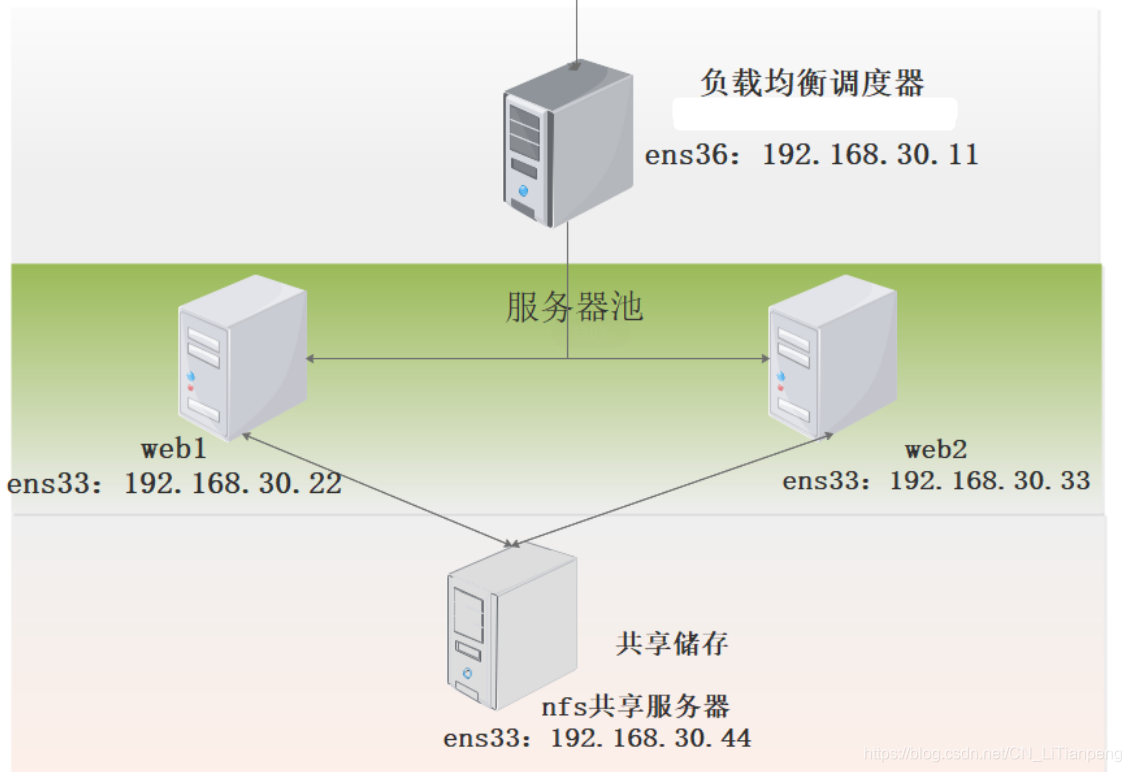haproxy高可用群集——詳細介紹及步驟
常見的Web叢集排程器
- 目前常見的Web叢集排程器分為軟體和硬體
- 軟體通常使用開源的LVS、Haproxy、Nginx
- 硬體一般使用比較多的是F5,也有很多人使用國內的一些產品,如梭子魚、綠盟等
haproxy介紹
Haproxy應用分析
- LVS在企業應用中抗負載能力很強,但存在不足
◆LVS不支援正則處理,不能實現動靜分離
◆對於大型網站,LVS的實施設定複雜,維護成本相對較高 - Haproxy是一款可提供高可用性、負載均衡、及基於TCP和HTTP應用的代理的軟體
◆適用於負載大的Web站點
◆執行在硬體上可支援數以萬計的並行連線的連線請求
Haproxy排程演演算法原理
Haproxy支援多種排程演演算法,最常用的有三種
1.RR(Round Robin)
RR演演算法是最簡單最常用的一種演演算法,即輪詢排程
理解舉例:
◆有三個節點A、B、C
◆第一個使用者存取會被指派到節點A
◆第二個使用者存取會被指派到節點B
◆第三個使用者存取會被指派到節點C
◆第四個使用者存取繼續指派到節點A,輪詢分配存取請求實現負載均衡效果
2.LC (Least Connections)
最小連線數演演算法,根據後端的節點連線數大小動態分配前端請求
理解舉例:
◆ 有三個節點A、B、C,各節點的連線數分別為A:4、B:5、C:6
◆ 第一個使用者連線請求,會被指派到A上,連線數變為A:5、B:5、C:6
◆ 第二個使用者請求會繼續分配到A上,連線數變為A:6、B:5、C:6;再有新的請求會分配給B,每次將新的請求指派給連線數最小的使用者端
◆ 由於實際情況下A、B、C的連線數會動態釋放,很難會出現一樣連線數的情況
◆ 此演演算法相比較rr演演算法有很大改進,是目前用到比較多的一種演演算法
3.SH (Source Hashing)
基於來源存取排程演演算法,用於一些有Session對談記錄在伺服器端的場景,可以基於來源的IP、Cookie等做叢集排程
理解舉例:
◆ 有三個節點A、B、C,第一個使用者第一次存取被指派到了A,第二個使用者第一次存取被指派到了B
◆ 當第一個使用者第二次存取時會被繼續指派到A,第二個使用者第二次存取時依舊會被指派到B,只要負載均衡排程器不重新啟動,第一個使用者存取都會被指派到A,第二個使用者存取都會被指派到B,實現叢集的排程
◆ 此排程演演算法好處是實現對談保持,但某些IP存取量非常大時會引起負載不均衡部分節點存取量超大,影響業務使用
Haproxy安裝與啟動
在負載均衡器上安裝Haproxy
安裝步驟
- 安裝基礎軟體包
- 編譯安裝haproxy
- 要注意作業系統版本,是32位元系統還是64位元
建立Haproxy的組態檔 - 建立組態檔目錄/etc/haproxy
- 將原始碼包提供的組態檔樣例haproxy.cfg複製到組態檔目錄中
Haproxy組態檔詳解
Haproxy組態檔通常分為三個部分
- global:為全域性設定
- defaults:為預設設定
- listen:為應用元件設定
global設定引數
| 引數 | 說明 |
|---|---|
| log 127.0.0.1 local0 | 設定紀錄檔記錄,local0為紀錄檔裝置,預設存放到系統紀錄檔 |
| log 127.0.0.1 local1 | noticenotice為紀錄檔級別,通常有24個級別 |
| maxconn 4096 | 最大連線數 |
| uid 99 | 使用者uid |
| gid 99 | 使用者gid |
haproxy搭建實操
haproxy群集拓撲圖

一、設定nfs共用儲存
[root@localhost ~]# ifconfig
ens33: flags=4163<UP,BROADCAST,RUNNING,MULTICAST> mtu 1500
inet 192.168.30.44 netmask 255.255.255.0 broadcast 192.168.30.255
inet6 fe80::a52a:406e:6512:1c66 prefixlen 64 scopeid 0x20<link>
[root@localhost ~]# route -n //檢視路由表,看閘道器
Destination Gateway Genmask Flags Metric Ref Use Iface
0.0.0.0 192.168.30.11 0.0.0.0 UG 100 0 0 ens33
192.168.30.0 0.0.0.0 255.255.255.0 U 100 0 0 ens33
192.168.122.0 0.0.0.0 255.255.255.0 U 0 0 0 virbr0
1.安裝相關軟體,並啟動nfs
[root@localhost ~]# rpm -q nfs-utils //檢視nfs是否安裝
nfs-utils-1.3.0-0.61.el7.x86_64
[root@localhost ~]# rpm -q rpcbind //檢視rpcbind是否安裝
rpcbind-0.2.0-47.el7.x86_64
[root@localhost ~]# yum -y install nfs-utils //確實安裝了
Loaded plugins: fastestmirror, langpacks
Loading mirror speeds from cached hostfile
Package 1:nfs-utils-1.3.0-0.61.el7.x86_64 already installed and latest version
Nothing to do
[root@localhost ~]# yum -y install rpcbind
Loaded plugins: fastestmirror, langpacks
Loading mirror speeds from cached hostfile
Package rpcbind-0.2.0-47.el7.x86_64 already installed and latest version
Nothing to do
[root@localhost ~]# systemctl start nfs
[root@localhost ~]# systemctl enable nfs
Created symlink from /etc/systemd/system/multi-user.target.wants/nfs-server.service to /usr/lib/systemd/system/nfs-server.service.
[root@localhost ~]# systemctl start rpcbind
[root@localhost ~]# systemctl enable rpcbind
2.設定共用目錄,並行布
[root@localhost ~]# vi /etc/exports
/opt/web1 192.168.30.0/24(rw,sync) //注意,這裡的ip與授權的「()」之間不能有空格
/opt/web2 192.168.30.0/24(rw,sync)
[root@localhost ~]# systemctl restart nfs
[root@localhost ~]# systemctl restart rpcbind
[root@localhost ~]# showmount -e //檢視共用目錄
Export list for localhost.localdomain:
/opt/web2 192.168.30.0/24
/opt/web1 192.168.30.0/24
[root@localhost web2]# exportfs -vr //釋出共用目錄
exporting 192.168.30.0/24:/opt/web2
exporting 192.168.30.0/24:/opt/web1
3.建立共用目錄,並製作測試網頁
[root@localhost ~]# mkdir /opt/web1/ /opt/web1/
[root@localhost ~]# vi /opt/web1/index.html
<html>
<title>I'm Web1</title>
<body><h1>I'm Web1</h1></body>
<img src="web1.jpg" />
</html>
[root@localhost ~]# vi /opt/web2/index.html
<html>
<title>I'm Web2</title>
<body><h1>I'm Web2</h1></body>
<img src="web2.png" />
</html>
二、設定Web1
1.安裝並啟動nginx
[root@localhost nginx-1.15.9]# tar xzvf nginx-1.15.9.tar.gz -C /opt
[root@localhost system]# useradd -s /sbin/nologin -M nginx //-M不建立家目錄
[root@localhost opt]# yum -y install \
gcc \
gcc-c++ \
make \
pcre-devel \
expat-devel \
perl \
zlib-devel
[root@localhost nginx-1.15.9]# cd /opt/nginx-1.15.9/
[root@localhost nginx-1.15.9]# ./configure \
--prefix=/usr/local/nginx \
--user=nginx \
--group=nginx \
--with-http_stub_status_module
[root@localhost nginx-1.15.9]# make && make install
[root@localhost nginx-1.15.9]# ln -s /usr/local/nginx/sbin/nginx /usr/local/sbin/
[root@localhost nginx-1.15.9]# killall -s QUIT nginx
[root@localhost nginx-1.15.9]# cd /lib/systemd/system/
[root@localhost system]# vim nginx.service //注意,設定執行服務檔案前關閉nginx程序
[Unit]
Description=nginx
After=network.target
[Service]
Type=forking
PIDFile=/usr/local/nginx/logs/nginx.pid
ExecStart=/usr/local/nginx/sbin/nginx
ExecReload=/usr/bin/kill -s HUP $MAINPID
ExecStop=/usr/bin/ki11 -s QUIT $MAINPID
PrivateTmp=true
[Install]
WantedBy=multi-user.target //允許多使用者
[root@localhost system]# chmod 754 nginx.service //給許可權,讓組使用者也可以執行
[root@localhost system]# systemctl start nginx.service
[root@localhost system]# systemctl enable nginx.service
[root@localhost system]# systemctl status nginx.service
● nginx.service - nginx
Loaded: loaded (/usr/lib/systemd/system/nginx.service; disabled; vendor preset: disabled)
Active: active (running) since Sun 2020-09-06 05:20:11 CST; 1s ago
Process: 13374 ExecStart=/usr/local/nginx/sbin/nginx (code=exited, status=0/SUCCESS)
……省略部分
2.掛載nfs共用儲存
[root@localhost system]# yum -y install nfs-utils rpcbind
[root@localhost system]# showmount -e 192.168.30.44
Export list for 192.168.30.44:
/opt/web2 192.168.30.0/24
/opt/web1 192.168.30.0/24
[root@localhost system]# mount 192.168.30.44:/opt/web1 /usr/local/nginx/html/
[root@localhost system]# vi /etc/fstab
192.168.30.44:/opt/web1 /usr/local/nginx/html nfs defaults,_netdev 0 0
3.測試共用儲存掛載

三、設定Web2
1.編譯安裝nginx
[root@localhost nginx-1.15.9]# tar xzvf nginx-1.15.9.tar.gz -C /opt
[root@localhost system]# useradd -s /sbin/nologin -M nginx //-M不建立家目錄
[root@localhost opt]# yum -y install \
gcc \
gcc-c++ \
make \
pcre-devel \
expat-devel \
perl \
zlib-devel
[root@localhost nginx-1.15.9]# cd /opt/nginx-1.15.9/
[root@localhost nginx-1.15.9]# ./configure \
--prefix=/usr/local/nginx \
--user=nginx \
--group=nginx \
--with-http_stub_status_module
[root@localhost nginx-1.15.9]# make && make install
[root@localhost nginx-1.15.9]# ln -s /usr/local/nginx/sbin/nginx /usr/local/sbin/
[root@localhost nginx-1.15.9]# killall -s QUIT nginx
[root@localhost nginx-1.15.9]# cd /lib/systemd/system/
[root@localhost system]# vim nginx.service //注意,設定執行服務檔案前關閉nginx程序
[Unit]
Description=nginx
After=network.target
[Service]
Type=forking
PIDFile=/usr/local/nginx/logs/nginx.pid
ExecStart=/usr/local/nginx/sbin/nginx
ExecReload=/usr/bin/kill -s HUP $MAINPID
ExecStop=/usr/bin/ki11 -s QUIT $MAINPID
PrivateTmp=true
[Install]
WantedBy=multi-user.target //允許多使用者
[root@localhost system]# chmod 754 nginx.service //給許可權,讓組使用者也可以執行
[root@localhost system]# systemctl start nginx.service
[root@localhost system]# systemctl enable nginx.service
[root@localhost system]# systemctl status nginx.service
● nginx.service - nginx
Loaded: loaded (/usr/lib/systemd/system/nginx.service; disabled; vendor preset: disabled)
Active: active (running) since Sun 2020-09-06 05:20:11 CST; 1s ago
Process: 13374 ExecStart=/usr/local/nginx/sbin/nginx (code=exited, status=0/SUCCESS)
……省略部分
2.掛載共用儲存目錄
[root@localhost system]# yum -y install nfs-utils rpcbind
[root@localhost system]# showmount -e 192.168.30.44
Export list for 192.168.30.44:
/opt/web2 192.168.30.0/24
/opt/web1 192.168.30.0/24
[root@localhost system]# mount 192.168.30.44:/opt/web2 /usr/local/nginx/html/
[root@localhost system]# vi /etc/fstab
192.168.30.44:/opt/web2 /usr/local/nginx/html nfs defaults,_netdev 0 0
3.測試共用儲存掛載

四、設定Haproxy負載均衡
1.編譯安裝haproxy
[root@localhost ~]# yum -y install pcre-devel bzip2-devel gcc gcc-c++ //安裝環境
[root@localhost ~]# tar xzvf haproxy-1.4.24.tar.gz -C /opt
[root@localhost ~]# cd /opt
[root@localhost opt]# cd haproxy-1.4.24/
[root@localhost haproxy-1.4.24]# make TARGET=linux26
[root@localhost haproxy-1.4.24]# make install
2.設定Haproxy服務
[root@localhost haproxy-1.4.24]# mkdir /etc/haproxy
[root@localhost haproxy-1.4.24]# cp examples/haproxy.cfg /etc/haproxy/
[root@localhost haproxy-1.4.24]# vi /etc/haproxy/haproxy.cfg
# this config needs haproxy-1.1.28 or haproxy-1.2.1
global
log 127.0.0.1 local0
log 127.0.0.1 local1 notice
#log loghost local0 info
maxconn 4096
chroot /usr/share/haproxy
uid 99
gid 99
daemon
#debug
#quiet
defaults
log global
mode http
option httplog
option dontlognull
retries 3
# redispatch
maxconn 2000
contimeout 5000
clitimeout 50000
srvtimeout 50000
listen appli1-rewrite 0.0.0.0:80
# cookie SERVERID rewrite
balance roundrobin
server inst1 192.168.30.22:80 check inter 2000 fall 3
server inst2 192.168.30.33:80 check inter 2000 fall 3
###############################上述組態檔解釋#############################
(1)Haproxy組態檔通常分為三個部分
global:為全域性設定
defaults:為預設設定
listen:為應用元件設定
global設定引數
log 127.0.0.1 local0:設定紀錄檔記錄,設定紀錄檔記錄,local0為紀錄檔裝置,預設存放到系統紀錄檔
log 127.0.0.1 local1 notice:notice為紀錄檔級別,通常有24個級別
maxconn 4096:最大連線數
uid 99:使用者uid gid 99:使用者gid
(2)defaults設定項設定預設引數,一般會被應用元件繼承,如果在應用元件中沒有特別宣告,將安裝預設設定引數設定
log global:定義紀錄檔為global設定中的紀錄檔定義
mode http:模式為http
option httplog:採用http紀錄檔格式記錄紀錄檔
option dontlognull :保證HAProxy不記錄上級負載均衡傳送過來的用於檢測狀態沒有資料的心跳包
retries 3:檢查節點伺服器失敗連續達到三次則認為節點不可用
maxconn 2000:最大連線數
contimeout 5000:連線超時時間
clitimeout 50000:使用者端超時時間
srvtimeout 50000:伺服器超時時間
(3)listen設定專案一般為設定應用模組引數
listen appli4-backup 0.0.0.0:10004:定義一個appli4-backup的應用
option httpchk /index.html:檢查伺服器的index.html檔案
option persist :強制將請求傳送到已經down掉的伺服器
balance roundrobin:負載均衡排程演演算法使用輪詢演演算法
server inst1 192.168.114.56:80 check inter 2000 fall 3:定義線上節點
server inst2 192.168.114.56:81 check inter 2000 fall 3 backup:定義備份節點
3.設定系統服務
[root@localhost haproxy-1.4.24]# cp examples/haproxy.init /etc/init.d/haproxy
[root@localhost haproxy-1.4.24]# chmod 755 /etc/init.d/haproxy
[root@localhost haproxy-1.4.24]# chkconfig --add haproxy
[root@localhost haproxy-1.4.24]# chkconfig --list haproxy
Note: This output shows SysV services only and does not include native
……省略部分
haproxy 0:off 1:off 2:off 3:off 4:off 5:off 6:off
[root@localhost haproxy-1.4.24]# ln -s /usr/local/sbin/haproxy /usr/sbin/haproxy
[root@localhost haproxy-1.4.24]# service haproxy start
[root@localhost haproxy-1.4.24]# systemctl stop haproxy.service
[root@localhost haproxy-1.4.24]# systemctl start haproxy.service
[root@localhost haproxy-1.4.24]# netstat -anupt |grep haproxy
tcp 0 0 0.0.0.0:80 0.0.0.0:* LISTEN 20379/haproxy
udp 0 0 0.0.0.0:46295 0.0.0.0:* 20379/haproxy
4.測試haproxy輪詢


5.haproxy存取紀錄檔設定
[root@localhost ~]# vi /etc/haproxy/haproxy.cfg
global
log /dev/log local0 //將log有關的設定換成這兩條
log /dev/log local1 notice
……省略部分
[root@localhost ~]# systemctl restart haproxy.service //重新啟動haproxy服務
[root@localhost ~]# vi /etc/rsyslog.d/haproxy.conf //重新編寫一個haproxy組態檔
if ($programname == 'haproxy' and $syslogseverity-text == 'info') then -/var/log/haproxy/haproxy-info.log
& ~
if ($programname == 'haproxy' and $syslogseverity-text == 'notice') then -/var/log/haproxy/haproxy-notice.log
& ~
[root@localhost ~]# systemctl restart rsyslog.service
[root@localhost ~]# tail -f /var/log/haproxy/haproxy-info.log
Sep 25 02:19:05 localhost haproxy[21757]: 192.168.30.1:53145 [25/Sep/2020:02:18:51.585] webcluster webcluster/inst1 0/0/0/1/13874 304 1083 - - CD-- 2/2/0/0/0 0/0 "GET / HTTP/1.1"
Sep 25 02:20:09 localhost haproxy[21757]: 192.168.30.1:53212 [25/Sep/2020:02:19:16.966] webcluster webcluster/inst2 0/0/2/1/52421 404 3550 - - cD-- 2/2/1/0/0 0/0 "GET /favicon.ico HTTP/1.1"
Sep 25 02:20:10 localhost haproxy[21757]: 192.168.30.1:53233 [25/Sep/2020:02:19:20.189] webcluster webcluster/inst1 0/0/1/1/50248 200 637 - - cD-- 0/0/0/0/0 0/0 "GET / HTTP/1.1"
6.Haproxy引數優化
隨著企業網站負載增加,haproxy引數優化相當重要
| 優化引數 | 含義 |
|---|---|
| maxconn | 最大連線數,根據應用實際情況進行調整,推薦使用10240 |
| daemon | 守護行程模式,Haproxy可以使用非守護行程模式啟動,建議使用守護行程模式啟動 |
| nbproc | 負載均衡的並行程序數,建議與當前伺服器CPU核數相等或為其2倍 |
| retries | 重試次數,主要用於對叢集節點的檢查,如果節點多,且並行量大,設定為2次或3次 |
| option http-server-close | 主動關閉http請求選項,建議在生產環境中使用此選項 |
| timeout http-keep-alive | 長連線超時時間,設定長連線超時時間,可以設定為10s |
| timeout http-request | http請求超時時間,建議將此時間設定為5~10s,增加http連線釋放速度 |
| timeout client | 使用者端超時時間,如果存取量過大,節點響應慢,可以將此時間設定短一些,建議設定為1min左右就可以了 |